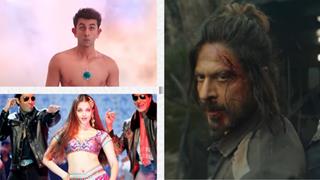Ram Gopal Varma's "Naach" isn't the first film about a girl's obsession with dance. Off and on Hindi
cinema has chosen to take on the theme with guts and glory.
Way back in 1948, dancing maestro Uday Shankar's "Kalpana" brought together him and his wife for a film
that was shot entirely as a dance ballet. The story of a young man's dream of setting up a dance academy
was embodied in the dance form.
In the same year as Kalpana, Tamil filmmaker S.S. Vasan directed another dance spectacle "Chandralekha"
in Tamil and Hindi.
The next big dance film, "Jhanak Jhanak Payal Baje", in 1955 also featured a real life couple. Director V.
Shantaram stood behind the camera to capture his wife Sandhya dancing on screen with eminent Kathak
exponent Gopi Krishna.
Time and again danseuses have stepped into Hindi cinema to lend authenticity to the much-manipulated and
subverted forms of classical dance in films.
The famed Gopi Krishna not only played the lead in "Jhanak Jhanak Payal Baje" but also choreographed the
famous "Mohe panghat pe" number in "Mughal-e-Azam" and appeared at the end of the film for a climactic
dance item.
Many decades later, kathak exponent Birju Maharaj was brought into Sanjay Leela Bhansali's "Devdas" at
the director's personal request to choreograph and also sang for Madhuri Dixit's dance number "Kahe
ched-ched mohe".
The dancer and the dance have in this way striven to be one in sporadic Hindi films over the years. Waheeda
Rehman in Vijay Anand's "Guide", Sandhya in V. Shantaram's "Jal Bin Machli Nritya Bin Bijli", Sudha
Chandran in T. Rama Rao's "Naache Mayuri", Jaya Prada in K. Vishwanath's "Sargam" and "Sur Sangam"
have lived only to dance...and how gloriously!
Then followed a long and dark absence of the dancer and the dance from the screen. Now by sheer
coincidence, two recent films about romancing the rhythms have been released one after another. In Pamela
Rooks' "Dance Like A Man" Sobhana and Arif Zakaria play a couple going through life practising their
bharatanatyam.
Barely a month later, there was Antara Mali in "Naach" as a choreographer whose dance isn't just a passion
but a reason and motivation to live.  Though Antara's obsessive and manic rhythms are far removed from the studied splendour of Uday and
Amala Shankar in "Kalpana", in many ways "Naach" represented the arrival of dance as a metaphor of life
coming to a full circle.
Though Antara's obsessive and manic rhythms are far removed from the studied splendour of Uday and
Amala Shankar in "Kalpana", in many ways "Naach" represented the arrival of dance as a metaphor of life
coming to a full circle.
If 49 years ago in "Jhanak Jhanak Payal Baje", V. Shantaram watched his wife's nimble feet take over the
frames, in "Naach", Ram Gopal Varma sat back to let Antara do the same.
Though the craft and technique of the two filmmakers are as dissimilar as humanly possible, at the end of the
day they both seem to say the same thing.
Life is dance and dance is life...Hey, didn't Mithun Chakraborty say that in B. Subhash's "Dance Dance" 19
years ago?
Antara's universal obsession !
Tuesday, December 07, 2004 13:07 IST



















